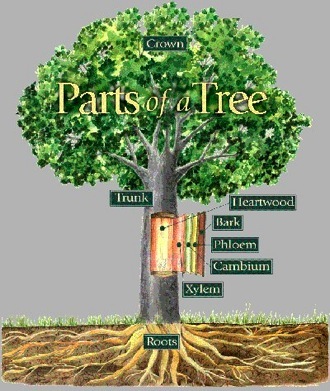Growing Big & Strong


Nutrition
Leaves serve as the location for photosynthesis (Wikimedia Commons)
In order for the Citrus reticulata to grow, it needs the seventeen “essential plant nutrients”, including carbon (C), hydrogen (H), oxygen (O), nitrogen (N), phosphorus (P), potassium (K), calcium (Ca), magnesium (Mg), sulfur (S), iron (Fe), zinc (Zn), manganese (Mn), boron (B), copper (Cu), molybdenum (Mo), chlorine (Cl), and nickel (Ni). It is able to get its carbon, hydrogen and oxygen from water and carbon dioxide, however, the other fourteen elements need to be obtained from the soil. These elements are sometimes referred to as the “mineral nutrients”. Generally with citrus trees, there is a concern only for obtaining the nitrogen, potassium and phosphorus elements because they are needed in mass quantity and have a tendency to limit production. The roots of citrus trees do not develop root hairs. Therefore, they are rely highly on getting their nutrients from their mutualistic relationship with fungi called mycorrhizae. Citrus reticulata also perform photosynthesis. This process of converting carbon dioxide and water plus light to glucose and oxygen is represented by the chemical equation: 6CO2 + 6H2O
(+ light energy) C6H12O6 + 6O2.
C6H12O6 + 6O2.
(+ light energy)

As vascular plants, Citrus reticulata, have primary and secondary growth. Through the use of a phloem and xylem, they transport nutrients. Phloem is the living tissue within the organism that transports nutrients such as sugar and sucrose from the leaves as a product of photosynthesis to all parts of the plant where it is needed. Phloem is found to be in the innermost layer of bark. Xylem transports water and dissolved minerals throughout the plant from the roots. It consists of long hollow cells. The vascular cambium begins to produce secondary xylem tissues when there is secondary growth. These new secondary xylem tissues cover the old xylem, making them become empty and dead. This causes them to lose their original function of transportation and serve only as a means of support, like a hard skeleton. That means that only the outermost parts of the trunk and older branches actually contain xylem that are serving their original purpose of transporting water.
tree parts (Kentucky Division of Forestry)
Transportation
Home
Moving on to how it reproduces...


